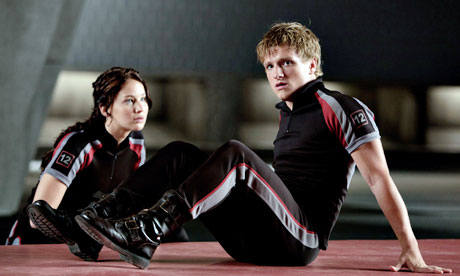The bestselling books - and forthcoming film – are only part of what has become a hugely popular genre. What's the reason for its success?
 Katniss Everdeen (Jennifer Lawrence) and Peeta Mellark (Josh Hutcherson) in The Hunger Games. Photograph: Murray Close
The Hunger Games – Suzanne Collins' bestselling trilogy, the film version of which is out this week – is part of a huge wave of dystopian fiction for children and young adults that has broken over the past few years. There's also Scott Westerfeld's Uglies series, the magnificent, heartbreaking and Carnegie medal-winning Chaos Walking trilogy by Patrick Ness (the film rights were sold in 2011 to the people behind the Hunger Games film), Michael Grant's bleak and terrifying Gone series, Lauren Oliver's Delirium (whose sequel Pandemonium is out this month) and last year's Costa Children's Award-winning Blood Red Road by Moira Young. These stories present worlds full of cowed populations, tyrannical governments, post-nuclear, pollution-devastated, war-torn landscapes, corrupt elites, weaponised viruses and other assorted horrors that ask how we would function in extremis and test what it means to be human.
Katniss Everdeen (Jennifer Lawrence) and Peeta Mellark (Josh Hutcherson) in The Hunger Games. Photograph: Murray Close
The Hunger Games – Suzanne Collins' bestselling trilogy, the film version of which is out this week – is part of a huge wave of dystopian fiction for children and young adults that has broken over the past few years. There's also Scott Westerfeld's Uglies series, the magnificent, heartbreaking and Carnegie medal-winning Chaos Walking trilogy by Patrick Ness (the film rights were sold in 2011 to the people behind the Hunger Games film), Michael Grant's bleak and terrifying Gone series, Lauren Oliver's Delirium (whose sequel Pandemonium is out this month) and last year's Costa Children's Award-winning Blood Red Road by Moira Young. These stories present worlds full of cowed populations, tyrannical governments, post-nuclear, pollution-devastated, war-torn landscapes, corrupt elites, weaponised viruses and other assorted horrors that ask how we would function in extremis and test what it means to be human.
How to explain their popularity? Perhaps these stories – of unhappy societies teetering on the brink of disaster and redemption – articulate the modern teenage experience (albeit an extreme version) of living with a wide and perpetual unease. Apocalyptic but coherent, resolvable narratives are handbooks for mental survival. Hunker down with the Knife of Never Letting Go in your hand and pray for daylight.
The bestselling books - and forthcoming film – are only part of what has become a hugely popular genre. What's the reason for its success?

Katniss Everdeen (Jennifer Lawrence) and Peeta Mellark (Josh Hutcherson) in The Hunger Games. Photograph: Murray Close
The Hunger Games – Suzanne Collins' bestselling trilogy, the film version of which is out this week – is part of a huge wave of dystopian fiction for children and young adults that has broken over the past few years. There's also Scott Westerfeld's Uglies series, the magnificent, heartbreaking and Carnegie medal-winning Chaos Walking trilogy by Patrick Ness (the film rights were sold in 2011 to the people behind the Hunger Games film), Michael Grant's bleak and terrifying Gone series, Lauren Oliver's Delirium (whose sequel Pandemonium is out this month) and last year's Costa Children's Award-winning Blood Red Road by Moira Young. These stories present worlds full of cowed populations, tyrannical governments, post-nuclear, pollution-devastated, war-torn landscapes, corrupt elites, weaponised viruses and other assorted horrors that ask how we would function in extremis and test what it means to be human.
How to explain their popularity? Perhaps these stories – of unhappy societies teetering on the brink of disaster and redemption – articulate the modern teenage experience (albeit an extreme version) of living with a wide and perpetual unease. Apocalyptic but coherent, resolvable narratives are handbooks for mental survival. Hunker down with the Knife of Never Letting Go in your hand and pray for daylight.
How to explain their popularity? Perhaps these stories – of unhappy societies teetering on the brink of disaster and redemption – articulate the modern teenage experience (albeit an extreme version) of living with a wide and perpetual unease. Apocalyptic but coherent, resolvable narratives are handbooks for mental survival. Hunker down with the Knife of Never Letting Go in your hand and pray for daylight.
1 comment:
I read all three, I am still shocked!
Post a Comment